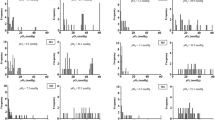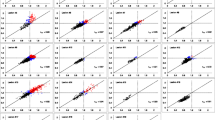Abstract
Purpose
There is growing recognition that biologic features of the tumor microenvironment affect the response to cancer therapies and the outcome of cancer patients. In head and neck cancer (HNC) one such feature is hypoxia. We investigated the utility of 18F-fluoromisonidazole (FMISO) dynamic positron emission tomography (dPET) for monitoring the early microenvironmental response to chemoradiotherapy in HNC.
Experimental design
Seventy-two HNC patients underwent FMISO dPET scans in a customized immobilization mask (0–30 min dynamic acquisition, followed by 10 min static acquisitions starting at ∼95 min and ∼160 min post-injection) at baseline and early into treatment where patients have already received one cycle of chemotherapy and anywhere from five to ten fractions of 2 Gy per fraction radiation therapy. Voxelwise pharmacokinetic modeling was conducted using an irreversible one-plasma two-tissue compartment model to calculate surrogate biomarkers of tumor hypoxia (k 3 and Tumor-to-Blood Ratio (TBR)), perfusion (K 1 ) and FMISO distribution volume (DV). Additionally, Tumor-to-Muscle Ratios (TMR) were derived by visual inspection by an experienced nuclear medicine physician, with TMR > 1.2 defining hypoxia.
Results
One hundred and thirty-five lesions in total were analyzed. TBR, k 3 and DV decreased on early response scans, while no significant change was observed for K 1 . The k 3 -TBR correlation decreased substantially from baseline scans (Pearson’s r = 0.72 and 0.76 for mean intratumor and pooled voxelwise values, respectively) to early response scans (Pearson’s r = 0.39 and 0.40, respectively). Both concordant and discordant examples of changes in intratumor k 3 and TBR were identified; the latter partially mediated by the change in DV. In 13 normoxic patients according to visual analysis (all having lesions with TMR = 1.2), subvolumes were identified where k 3 indicated the presence of hypoxia.
Conclusion
Pharmacokinetic modeling of FMISO dynamic PET reveals a more detailed characterization of the tumor microenvironment and assessment of response to chemoradiotherapy in HNC patients than a single static image does. In a clinical trial where absence of hypoxia in primary tumor and lymph nodes would lead to de-escalation of therapy, the observed disagreement between visual analysis and pharmacokinetic modeling results would have affected patient management in <20% cases. While simple static PET imaging is easily implemented for clinical trials, the clinical applicability of pharmacokinetic modeling remains to be investigated.




Similar content being viewed by others
References
Schöder H, Fury M, Lee N, Kraus D. PET monitoring of therapy response in head and neck squamous cell carcinoma. J Nucl Med. 2009;50(Suppl 1):74S–88S.
Moding EJ, Kastan MB, Kirsch DG. Strategies for optimizing the response of cancer and normal tissue to radiation. Nat Rev Drug Discov. 2013;12:526–42.
Dubois LJ, Niemans R, van Kuijk SK, et al. New ways to image and target tumour hypoxia and its molecular responses. Radiother Oncol. 2015;116:352–7.
van Dijk LK, Boerman OC, Kaanders JH, Bussink J. PET imaging in head and neck cancer patients to monitor treatment response: a future role for EGFR-targeted imaging. Clin Cancer Res. 2015;21:3602–9.
Yankeelov TE, Mankoff DA, Schwartz LH, et al. Quantitative imaging in cancer clinical trials. Clin Cancer Res. 2016;22:284–90.
Lee NY, Schöder H, Beattie B, et al. Strategy of using Intratreatment hypoxia imaging to selectively and safely guide radiation dose de-escalation concurrent with chemotherapy for Locoregionally advanced human papillomavirus-related oropharyngeal carcinoma. Int J Radiat Oncol Biol Phys. 2016;96:9–17.
Yeh JJ, Kim WY. Targeting tumor hypoxia with hypoxia-activated prodrugs. J Clin Oncol. 2015;33:1505–8.
Padhani AR, Miles KA. Multiparametric imaging of tumor response to therapy. Radiology. 2010;2:348–64.
Sharma RA, Plummer R, Stock JK, et al. Clinical development of new drug-radiotherapy combinations. Nat Rev Clin Oncol. 2016;13:627–42.
Horsman MR, Mortensen LS, Petersen JB, Busk M, Overgaard J. Imaging hypoxia to improve radiotherapy outcome. Nat Rev Clin Oncol. 2012;9:674–87.
Overgaard J. Hypoxic modification of radiotherapy in squamous cell carcinoma of the head and neck--a systematic review and meta-analysis. Radiother Oncol. 2011;100:22–32.
Lim AM, Rischin D, Fisher R, et al. Prognostic significance of plasma osteopontin in patients with locoregionally advanced head and neck squamous cell carcinoma treated on TROG 02.02 phase III trial. Clin Cancer Res. 2012;18:301–7.
DiSilvestro PA, Ali S, Craighead PS, et al. Phase III randomized trial of weekly cisplatin and irradiation versus cisplatin and tirapazamine and irradiation in stages IB2, IIA, IIB, IIIB, and IVA cervical carcinoma limited to the pelvis: a gynecologic oncology group study. J Clin Oncol. 2014;32:458–64.
Koh WJ, Rasey JS, Evans ML, et al. Imaging of hypoxia in human tumors with [F-18]fluoromisonidazole. Int J Radiat Oncol Biol Phys. 1992;22:199–212.
Rasey JS, Koh WJ, Evans ML, et al. Quantifying regional hypoxia in human tumors with positron emission tomography of [18F]fluoromisonidazole: a pretherapy study of 37 patients. Int J Radiat Oncol Biol Phys. 1996;36:417–28.
Okamoto S, Shiga T, Yasuda K, et al. High reproducibility of tumor hypoxia evaluated by 18F-fluoromisonidazole PET for head and neck cancer. J Nucl Med. 2013;54:201–7.
Grkovski M, Schwartz J, Rimner A, et al. Reproducibility of 18F-fluoromisonidazole intratumour distribution in non-small cell lung cancer. EJNMMI Res. 2016;6:79.
Grkovski M, Schöder H, Lee NY, et al. Multiparametric imaging of tumor hypoxia and perfusion with 18F-fluoromisonidazole dynamic PET in head and neck cancer. J Nucl Med. 2017; doi:10.2967/jnumed.116.188649.
Koch CJ, Evans SM. Optimizing hypoxia detection and treatment strategies. Semin Nucl Med. 2015;45:163–76.
Rajendran JG, Mankoff DA. Positron emission tomography imaging of blood flow and hypoxia in tumors. In: Shields AF, Price P (eds) In vivo imaging of cancer therapy. Springer Science & Business Media, 2007.
Kadrmas DJ, Hoffman JM. Methodology for quantitative rapid multi-tracer PET tumor characterizations. Theranostics. 2013;3:757–73.
Dunnwald LK, Gralow JR, Ellis GK, Livingston RB, Linden HM, Specht JM, et al. Tumor metabolism and blood flow changes by positron emission tomography: relation to survival in patients treated with neoadjuvant chemotherapy for locally advanced breast cancer. J Clin Oncol. 2008;26:4449–57.
Komar G, Kauhanen S, Liukko K, Seppänen M, Kajander S, Ovaska J, et al. Decreased blood flow with increased metabolic activity: a novel sign of pancreatic tumor aggressiveness. Clin Cancer Res. 2009;15:5511–7.
Zips D, Zöphel K, Abolmaali N, et al. Exploratory prospective trial of hypoxia-specific PET imaging during radiochemotherapy in patients with locally advanced head-and-neck cancer. Radiother Oncol. 2012;105:21–8.
Wiedenmann NE, Bucher S, Hentschel M, et al. Serial [18F]-fluoromisonidazole PET during radiochemotherapy for locally advanced head and neck cancer and its correlation with outcome. Radiother Oncol. 2015;117:113–7.
Barcellos-Hoff MH, Park C, Wright EG. Radiation and the microenvironment - tumorigenesis and therapy. Nat Rev Cancer. 2005;5:867–75.
Dewhirst MW, Cao Y, Moeller B. Cycling hypoxia and free radicals regulate angiogenesis and radiotherapy response. Nat Rev Cancer. 2008;8:425–37.
Paudyal R, Oh JH, Riaz N, et al. Intravoxel incoherent motion diffusion-weighted MRI during chemoradiation therapy to characterize and monitor treatment response in human papillomavirus head and neck squamous cell carcinoma. J Magn Reson Imaging. 2017;45:1013–23.
Grkovski M, Emmas SA, Carlin SD. 18F-fluoromisonidazole kinetic modeling for characterization of tumor perfusion and hypoxia in response to antiangiogenic therapy. J Nucl Med. 2017; doi:10.2967/jnumed.117.190892.
Author information
Authors and Affiliations
Corresponding author
Ethics declarations
Funding
This study was supported by NIH grants 5R01CA157770–04 (P.I. Nancy Y. Lee), U01 CA157442–3 (P.I. Sadek A. Nehmeh) and the Cancer Center grant P30 CA008748 (P.I. Craig B. Thompson).
Conflict of interest
The authors declare no potential conflicts of interest.
Ethical approval
All procedures performed in studies involving human participants were in accordance with the ethical standards of the institutional and/or national research committee and with the 1964 Helsinki Declaration and its later amendments or comparable ethical standards.
Informed consent
Informed consent was obtained from all individual participants included in the study.
Electronic supplementary material
Supplementary Table S1
(DOCX 55 kb)
Supplementary Figure S1
(DOCX 521 kb)
Rights and permissions
About this article
Cite this article
Grkovski, M., Lee, N.Y., Schöder, H. et al. Monitoring early response to chemoradiotherapy with 18F-FMISO dynamic PET in head and neck cancer. Eur J Nucl Med Mol Imaging 44, 1682–1691 (2017). https://doi.org/10.1007/s00259-017-3720-6
Received:
Accepted:
Published:
Issue Date:
DOI: https://doi.org/10.1007/s00259-017-3720-6




